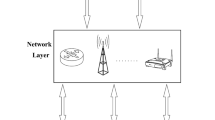Abstract
In recent years, Taiwan has been seeing an extension of the average life expectancy and a drop in overall fertility rate, initiating our country into an aged society. Due to this phenomenon, how to provide the elderly and patients with chronic diseases a suitable healthcare environment has become a critical issue presently. Therefore, we propose a new scheme that integrates healthcare services with wireless sensor technology in which sensor nodes are employed to measure patients’ vital signs. Data collected from these sensor nodes are then transmitted to mobile devices of the medical staff and system administrator, promptly enabling them to understand the patients’ condition in real time, which will significantly improve patients’ healthcare quality. As per the personal data protection act, patients’ vital signs can only be accessed by authorized medical staff. In order to protect patients’, the system administrator will verify the medical staff’s identity through the mobile device using a smart card and password mechanism. Accordingly, only the verified medical staff can obtain patients’ vital signs data such as their blood pressure, pulsation, and body temperature, etc.. Besides, the scheme includes a time-bounded characteristic that allows the verified staff access to data without having to have to re-authenticate and re-login into the system within a set period of time. Consequently, the time-bounded property also increases the work efficiency of the system administrator and user.

















Similar content being viewed by others
References
Partnership for Solutions, Chronic Conditions: Making the Case for Ongoing Care, Johns Hopkins University, 2004.
Akyildiz, I. F., Su, W., Sankarasubramaniam, Y., and Cyirci, E., A survey on sensor networks. IEEE Communications Magazine 40(8):102–114, 2002.
Jansen, M. B., and Eradus, W., Future developments on devices for animal radio frequency identification. Computer and Electronics in Agriculture 24(1–2):109–117, 1999.
Simmons, G. J., Contemporary Cryptology: The Science of Information Integrity, IEEE, 1992.
Chang, C. C., and Wu, T. C., Remote password authentication with smart cards. IEEE Computers and Digital Techniques 138(3):165–168, 1991.
Falas, T., and Kashani, H., Two-dimensional bar-code decoding with camera-equipped mobile phones. Proceedings of the Fifth Annual IEEE International Conference on Pervasive Computing and Communications Workshops, 597–600, 2007.
Hwang, M. S., A remote login authentication scheme based on the digital signature method. International Journal of Computer Mathematics 70(4):657–666, 1999.
Hwang, M. S., Cryptanalysis of a remote login authentication scheme. Computer Communications 22(8):742–744, 1999.
Hwang, T. L., Chen, Y. W., and Laih, C. S., Non-interactive password authentications without password tables. IEEE Region 10 Conference on Computer and Communication System, 429–431, 1990.
Hwang, M. S., and Li, L. H., A new remote user authentication scheme using smart cards. IEEE Transactions on Consumer Electronics 46(1):28–30, 2000.
Wong, K. H. M., Zheng, Y., Cao, J., and Wang, S., A dynamic user authentication scheme for wireless sensor networks. IEEE International Conference on Sensor Network Ubiquitous, and Trustworthy Computing 1:318–327, 2006.
Tseng, H. R., Jan, R. H., and Yang, W., An improved dynamic user authentication scheme for wireless sensor networks. IEEE on Global Telecommunications Conference, 986–990, 2007.
Das, M. L., Two-factor user authentication in wireless sensor networks. IEEE Transactions on Wireless Communications 8(3):1086–1090, 2009.
Khan, M. K., and Alghathbar, K., Cryptanalysis and security improvements of ‘two-factor user authentication in wireless sensor networks’. Sensors 10(3):2450–2459, 2010.
Vaidya, B., Makrakis, D., and Mouftah, H. T., Improved two-factor user authentication in wireless sensor networks. IEEE 6th International Conference on Wireless and Mobile Computing, Networking and Communications, 600–606, 2010.
Watro, R., Kong, D., Cuti, S., Gardiner, C., Lynn, C., and Kruus, P., TinyPK: securing sensor networks with public key technology. Proceding of the 2nd ACM Workshop Security of Ad Hoc Sensor Networks, 59–64, 2004.
Wu, F. N., Li, I. H., and Liao, I. E., A traffic load-aware energy efficient protocol for wireless sensor networks. Proceeding of the International Conference on Mobile Technology, Applications, and System, 2008.
Acknowledgment
This work was supported partially by National Science Council of Republic of China under Grants NSC 100-2410-H-029-007.
Author information
Authors and Affiliations
Corresponding author
Rights and permissions
About this article
Cite this article
Hsiao, TC., Liao, YT., Huang, JY. et al. An Authentication Scheme to Healthcare Security under Wireless Sensor Networks. J Med Syst 36, 3649–3664 (2012). https://doi.org/10.1007/s10916-012-9839-x
Received:
Accepted:
Published:
Issue Date:
DOI: https://doi.org/10.1007/s10916-012-9839-x




